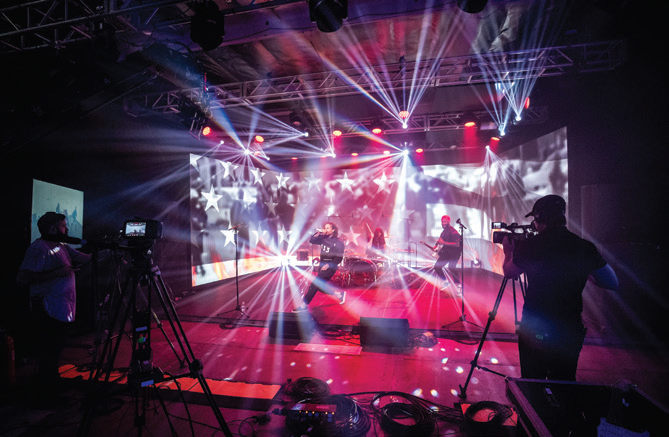
While acts can bring in their full crew, typically Bishop and Garcia are manning the feeds going out online. “It’s like doing a late-night show where the house engineer knows how to make it sound great for television,” Garcia explains. “If a band is heavy on backing tracks, they might sub-mix that for Spenser, but we’ve spent a lot of time making sure this sounds good for the Internet so we’re the last line of defense audio and video-wise.”

“That’s probably the best way to think of it,” Bishop puts in, “like late night TV, but when we’re live streaming we also have a feed up so the band can see what fans are saying online and interact with them in real time – seeing their comments and then responding, vocally, over the stream, which is really cool.”
While it may not be live as we know it, it’s far nearer to the real thing in terms of immediacy and energy for musicians, crew and audience members than other ‘at home’ virtual options, they note. “I tell bands that it’s like playing a festival,” Bishop says. “You come in. We have back line if you need it. If not, you just give us your stage plot, drop your gear, sound check, and then play a show.”
Looking To The Future
Musical performances are only one of the many applications they can support with this setup, however – corporate events, virtual conferences, film and commercial shoots, weddings, educational seminars – any of these can just as easily be mounted in the space. In essence, it can serve performers in virtually any discipline and clients of all descriptions safely, and in line with evolving regulations for physical distancing and group gatherings.
Given that there’s no hard, fast way of telling when – at least as far as live music is concerned – this will be going back to “normal,” it’s likely there could be a growing need for this type of space and service for the foreseeable future. As interest and the usage of the space increases, Bishop and Garcia indicate that they will continue to expand and enhance both the technology and services they offer.

As noted earlier, it’s something they’ve wanted to do for quite some time, anyway, and they intend to keep building on it as time goes on. “Kevin has a creative skill set that I was looking for before we met,” Bishop says. “Because I was always getting people asking, ‘Can you record us playing live?’ or ‘Can you do a music video in your shop?’ That wasn’t really possible to do with the quality that I wanted to have until we met. When we first started working together, we set up in a corner in the shop and did a few videos, but now we have this great studio that I’ve been dreaming about since we met. And I feel like now we’re at the level where, even after the pandemic, we’ll be able to keep this rolling.”
“Soundstages have always been a thing. Filming videos has always been a thing,” Garcia adds. “And I’m thinking, especially for the first year or two, if an artist or a band is more prone to getting sick, they’re not going to be comfortable going out, maybe even with a vaccine.”
The virtual and physical aspects of performance have been becoming more closely integrated in recent times, and that trend is quite likely to continue, both accelerated and bolstered by the pandemic. “I definitely see hybrid concerts happening more,” Bishop concludes. “Maybe smaller venues with big artists selling tickets online for five bucks, or whatever. There are going to be all kinds of new ideas coming down the pipeline as we learn from this and are forced in new direction.”
